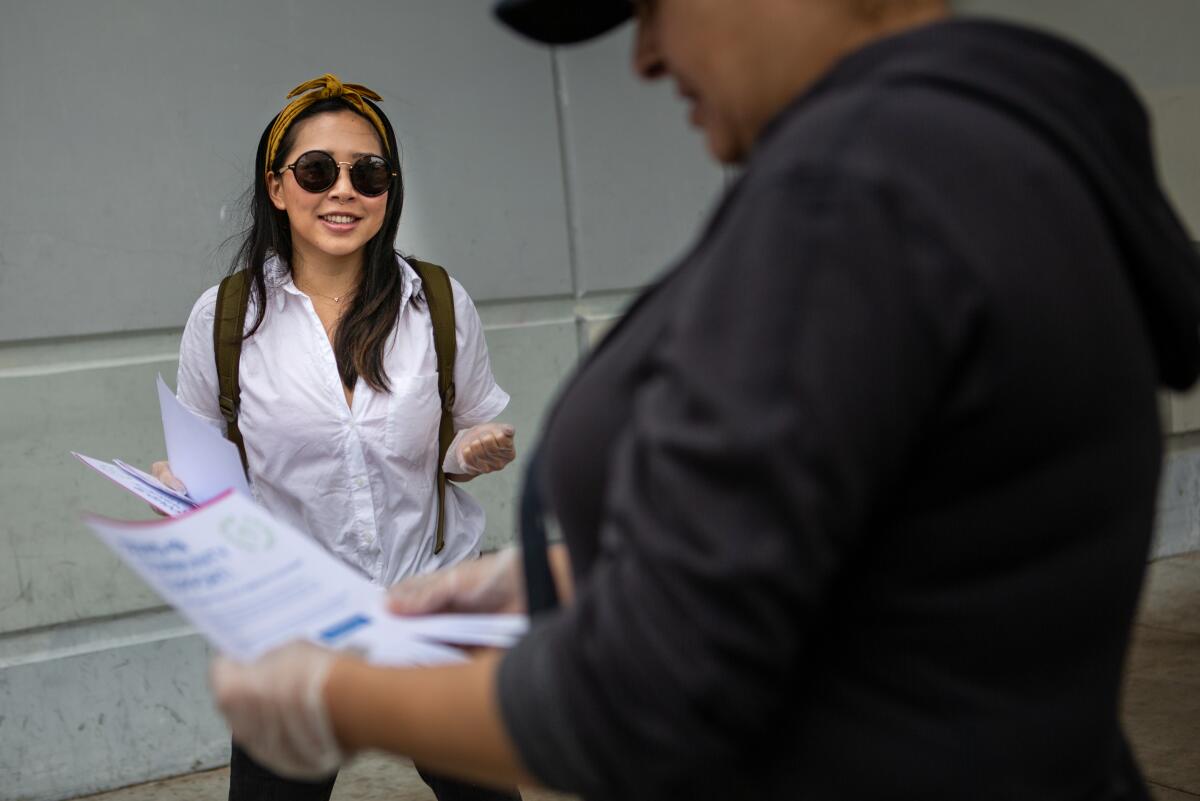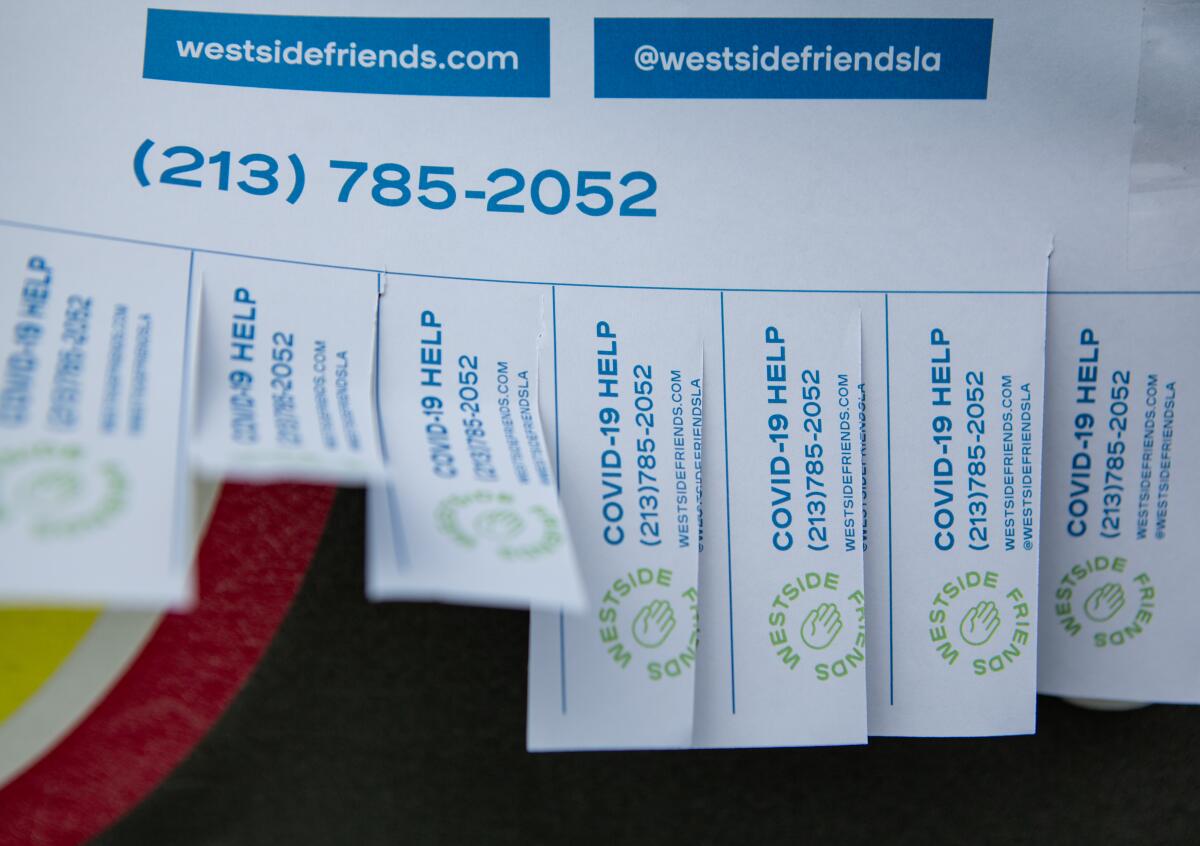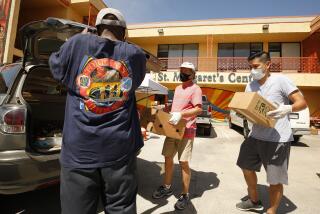The coronavirus is straining government services. So these neighbors are stepping up to help

- Share via
A day after the World Health Organization declared the coronavirus outbreak a pandemic, friends Annie Bickerton and Cristin Lim knew they couldn’t wait around for government to help.
The two millennials mobilized, as Bickerton, 33, went to Lim, 24, with an idea.
“Can you help me make a website for a rapid response thing for neighbors if COVID gets really bad?” Bickerton texted Lim.
In a matter of hours, they had launched Westside Friends, a network of neighbors helping one another during the outbreak with grocery runs, meals, pharmacy pickups, check-in calls and other errands.
Their skills aligned perfectly.
Bickerton works in public policy and has a knack for rallying people. She organized a core group of volunteers.
Lim is a freelance designer who always thinks of her audience. She created a domain, designed and developed the group’s website and crafted printable fliers in English and Spanish.
In a matter of days, more than 350 people signed up to volunteer.
“Our government is already at capacity right now,” Bickerton said. “We really need to show up as neighbors for each other right now and fill in the gaps.”

Despite being told they need to practice social distancing, Southern Californians — from Santa Monica to Santa Ana — are finding new ways to come together and turn to their neighbors for support and guidance. Faced with unclear direction from government officials, communities across the nation are taking steps to look out for one another, forming strong neighborhood ties.
“I feel like we are in a moment in time where we are watching a lot of systems feel like they are crumbling, and we feel paralyzed. We feel helpless in this big thing. This is a tangible way for someone to help,” Bickerton said about Westside Friends. “A lot of us are reading the news and feeling anxious and wondering what’s coming, but we can turn to our neighbors and offer to pick up extra groceries. Something simple can make a huge difference.”
As of Tuesday, Westside Friends had helped more than 50 people. Bickerton and Lim had deployed more than 60 block captains throughout the Westside who reach out to their immediate neighbors and serve as a point of contact for requests for help. They created a phone number people can call for assistance. The pair also launched a similar program in San Bernardino County.
Lim said she hopes that more people are encouraged to start something similar in their own communities. She’s made the fliers, block captain manual and other information available on the website so that others can duplicate their efforts.
“It’s in our hands, and nobody knows about your neighborhood better than you,” she said. “I feel like the earlier people can organize and create this network, the better off everyone will be. If you find what I’m doing inspiring, then do it too.”

During Westside Friends’ first week, people who called for help tended to be disabled, chronically ill and elderly. One needed a meal delivery. Another asked for someone to pick up her prescriptions.
Yet another was a woman who was immunocompromised. She didn’t need help but wanted to make sure that she had someone to call in case she did. Some who called lived outside the Westside area but had gotten a hold of the number. Westside Friends still sent help.
The next wave of calls came from people who had been laid off. They asked for food.
By the third week, Bickerton said, they were working on providing mental health resources and setting up check-in calls or chats for people who live alone. Westside Friends also matched more than 25 young volunteers with older folks. For instance, a USC student is now doing weekly grocery deliveries and pharmacy pickups for a senior citizen in Mar Vista.
So far, the help is greater than the need, Bickerton said.
In Santa Ana, it’s a similar story.
A little more than two weeks ago, Nathaniel Cooper, 38, recruited more than a dozen of his neighbors to serve as volunteers in Washington Square, a historic neighborhood in downtown Santa Ana. They walked door to door, dropping off fliers on neighbors’ doorsteps.
“So far it’s a glorified toilet paper ring,” Cooper said. He described it as a good thing but expects the need to grow in the coming weeks, as a wave of illness is predicted to hit Southern California.
To date, the group has fielded one call from someone who wanted to know how to get tested for COVID-19. That neighbor was given the phone number to the Orange County health department. One neighbor connected with another who could help with child care.
In other cases, people have helped connect informally on the Washington Square Neighborhood Assn.’s Facebook page. One neighbor offered lemons on her porch for the taking. Another offered free cat food. One mother offered a free set of toy train tracks.
But some are raising concerns that such acts of kindness could lead to inadvertent spread of the virus.
In New York City, a council member from hard-hit Brooklyn was quoted as saying he had concerns that volunteers helping neighbors could put some of the most vulnerable at risk.
Bickerton said Westside Friends already provides guidelines on how to keep oneself and others safe during deliveries, such as dropping off groceries at doorsteps and frequent hand washing. She said the group will continue to adapt and respond to the risks involved.
“But even a grocery delivery involves handling by a chain of people who could spread illness. Any time a package is handled or a door is opened, we run a risk,” she said. “We also run a risk of leaving behind our community members at a time of incredible need, from strains on mental health to job loss to a fear of the unknown. We can’t afford not to help each other now.”
In Culver City, Dan O’Brien, who administers the city’s unofficial Facebook page, first put up a quick post for volunteers on the group’s page. It has more than 10,000 members.
“If you want to help, just say ‘me’ in the comments field,” he posted. He had a few hundred people chime in.
That’s when O’Brien, a television and film editor, decided to coordinate volunteers. He created a Google document that volunteers can fill out with what they are willing to do. More than 150 signed up in the first few days.
In some ways, this kind of grass-roots organizing can be more efficient than government, which often contends with inherent challenges, O’Brien said.
“We don’t have to deal with all the hurdles they have to deal with, making sure all our I’s are dotted and Ts are crossed,” he said.
But overseeing a Facebook group of thousands of neighbors presents its own challenges, O’Brien said.
“Sometimes the page can get political and quickly turn ugly,” O’Brien said of the Facebook page. “But just when I’m ready to burn it all down, someone will ask for help and a thousand people will jump in.”
More to Read
Sign up for Essential California
The most important California stories and recommendations in your inbox every morning.
You may occasionally receive promotional content from the Los Angeles Times.











